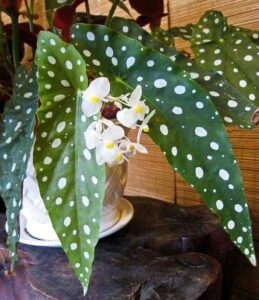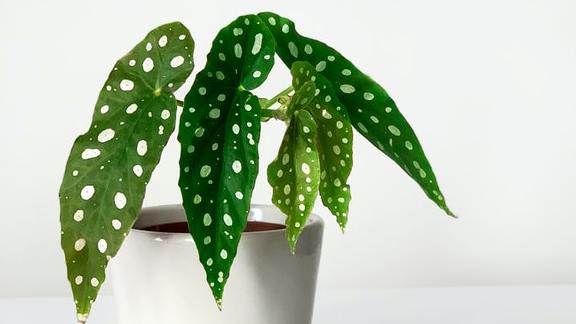We use affiliate links to run our site. When you buy through links on our site, we may earn an affiliate commission, without any added cost to you. Learn more
Begonia Maculata or spotted begonia is one of the most popular houseplants because it’s low maintenance and so easy to care for. They are also known as polka dot begonias.
What makes them so different from other begonias is their leaves, particularly the spots on their leaves. They can easily adapt and survive different weather conditions.
In this post, I will guide you on how to grow Begonia Maculata or spotted begonia in your house and tell you everything you need to know about growing begonia.
If you are interested in growing some of your own, read on…
To grow Begonia Maculata you need well-drained, well-aerated moist soil, bright indirect light and a temperature between 18°C to 30°C. Feed them every two to four weeks. Give them some occasional pruning, and the begonia will grow like wildfire!
Begonia Maculata is a beautiful, white-flowered perennial that comes from the tropical forests of Brazil. Being a tropical houseplant it needs warmth, strong filtered light and consistent moisture to survive in the home environment.
The Spotted Begonias are a fairly fast grower and can reach one meter or more in height. Although all Begonia plants are known for their beautiful flowers, the Begonia Maculata may be the prettiest of them all.
Some common names of the plant are Spotted Begonia, Polka Dot Begonia, Begonia Maculata.
Is Polka Dot Begonia Toxic?
All parts of a Polka Dot Begonia plant are toxic to cats, dogs, and horses. The oxalic acid in the juicy tissues can cause eye burns, nausea, vomiting, diarrhoea, and even death if they are eaten in large quantities.
As long as they are planted outside or in a room off-limits to pets, Polka Dot Begonia is not only gorgeous but quite safe.

How to Grow Begonia maculata/Spotted Begonia/Polka Dot Begonia
Soil:
Polka Dot begonia does best in well-draining soil that holds moisture without becoming soggy.
Soil preparation for growing spotted Begonia indoors is quite different from when you are growing them outside. Here you generally want to avoid amendments like compost and manure.
This is because it can cause excessive water retention, often resulting in root rots and other diseases for your begonias. You can use a good commercial mix for growing Polka dot begonias in a pot. Also, add a bit of perlite (not vermiculite) and some wood chips into the mix.
Light:
The Spotted Begonias grows best in bright indirect light, but they can also tolerate lower light levels. If the begonia gets too much direct sunlight, the leaves will burn and dry out.
On the other hand, if it doesn’t get enough light, it will become leggy and unattractive. So it becomes a bit tricky.
But If you have to choose between a spot for your Begonia Maculata either in full sunlight or somewhere with very little light, opt for the low-light spot. This plant has a better chance of surviving there. Besides, you can always light up the place using some grow lights.
The best way to grow begonias is to use fluorescent lights. You can buy these lights easily online or at garden stores. Either hang them above the plants or put them on stands with mirrors so they shine directly on the plant.
Keep them switched on for 14 hours per day or in the evenings after the sun goes down.
Temperature:
The Polka Dot begonias are tropical plants. If you want to grow them indoors, you’ll need to bring them in before the weather turns cold. The ideal temperature for growing spotted begonias is between 65°F (18°C) and 86°F (30°C).
They prefer daytime temperatures between 80°F (27°C) and 95F (35°C). Polka Dot Begonias are not hardy in areas where frost occurs, so keep them indoors at least 6 weeks before your first frost date.
Humidity:
Okay, here’s the thing about humidity: It’s really important for growing polka dot begonias. If you don’t give it enough moisture, your polka dots won’t grow properly, suffer leaf loss and stop flowering. They might even die.
Keep the humidity high and you’ll see that they do really well. Those who understand this basic need of the spotted begonias tend to have the best results.
The best way to achieve high humidity for your begonias is to invest in a humidifier. Keep a humidity level of 45% or above. Use a hygrometer like this to keep an eye on the humidity level on a constant basis.
Water:
To keep your begonias thriving keep them properly watered. Begonia Maculata likes to get watered when its soil is dry. Let the soil dry between watering, then water thoroughly till water drains out from the bottom.
Water the begonia more frequently in spring and summer during growth periods. As winter approaches water less and less often. Your spotted begonia will slow down the growth considerable in winters but it won’t go dormant like many other plants.
Fertilizer:
If you’re growing some spotted begonias indoors and want to encourage your plants to produce larger flowers and more leaves, then fertilizing is a good idea. Begonias generally aren’t heavy feeders, but they do appreciate a bit of feeding during the warm-weather months.
I always suggest using a balanced fertilizer with equal numbers of nitrogen-phosphorus-potassium (NPK) to fertilize the plant. But don’t overdo it or you might end up with brown tips and edges on those beautiful leaves.
Taking care of your Polka Dot Begonia:
Pruning:
To make it fuller and bushier you need to pinch and prune your Begonia regularly.
The mildest form of pruning is pinching out the tips. You can use your finger and thumb to pinch the cane tips from the plant. You can do this throughout the growing season.
The best time to prune a Spotted Begonia is in late autumn after it finished flowering. With the help of some pruning scissors, trim back long stems and help your plant conserve energy during cold winter months. New stems will grow from where you prune.
Repotting:
To keep your Begonia Maculata healthy, it’s important to repot them annually. This will ensure your plants are healthy and growing well. Over time they start to get root-bound and entangled,
As Begonia Maculatas get top-heavy, choose pots that are heavy – terracotta or stone to repot them. Don’t use a much bigger pot just a bit large size pot will be the best option. Spotted Begonias prefer to be a bit rootbound in small pots.
Pest and Disease of Begonia Maculata
Begonia Maculata is quite prone to pests and diseases. Most are caused by poor hygiene or careless practices. Here are some common pests and diseases of spotted begonias
- Powdery Mildew: It begins with circular spots of white powdery looking cover on foliage and spreads to other parts of the plant.
- Botrytis: causes soggy, brown splotches.
- Bacterial Leaf Spot: causes pimple-like leaf spots
- Pythium Root Rot: turns roots yellow and lower stems black
- Mealybugs And Whiteflies: they colonize under leaves and stem joints. Use insecticidal soap sprays and oils to deter them.
Conclusion:
Begonia Maculata is the most popular Begonia species for indoor growing. The plant can easily adapt to any changes in temperature and lighting and it has an extraordinary ability to survive. It’s a plant that’s really easy to grow, so you should try your luck and start your own Begonia Maculata at home.
It has been enjoyed by generations of indoor gardeners and now, you can also decorate your own home with the exotic beauty of Begonia Maculata.
I hope you found this post informational and it’s made you consider adding Begonia Maculata to your garden. Please do leave a comment and let us know if you have any questions.
Amazon and the Amazon logo are trademarks of Amazon.com, Inc, or its affiliates.

Hi there! My name is Prasenjit and I’m an avid gardener and someone who has grown a passion for growing plants. From my hands-on experience, I have learned what works and what doesn’t. Here I share everything I have learned.
